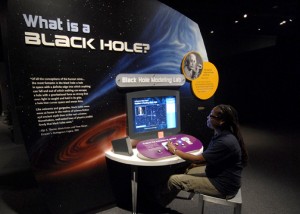New exhibition takes visitors through space and time
A new traveling exhibition created by educators and scientists at the Harvard-Smithsonian Center for Astrophysics pulls visitors into an exploration of the most mysterious and powerful objects in the universe. “Black Holes: Space Warps & Time Shifts” opened June 21 at the Boston Museum of Science, where it will remain on view through Sept. 21.
Photo (Click on thumbnail for full-size image.) Our own galaxy contains a supermassive black hole known as Sagittarius A*. (Image courtesy of the Chandra X-ray Observatory Center)
Black holes are regions in space with gravity so powerful that nothing can escape, and where time and space are warped beyond our understanding. The exhibition will guide visitors on a journey to the edge of these strange objects to discover how the latest research is turning science fiction into fact, challenging our notions of space and time in the process.

Project director Mary Dussault and other scientists and educators spent more than two years designing the exhibition. (Photo by Clive Grainger)
Project director Mary Dussault explains, “In this exhibition, we wanted to use the inherent fascination of black holes as a compelling vehicle to engage museum visitors in the larger story of how scientific discovery works—and how science is connected to human curiosity, imagination and culture.”
CfA personnel spent two-and-a-half years planning, designing and constructing the 2,500-square-foot exhibition. Its interactive stations address a number of questions:
- What is a black hole?
- Where are they?
- How do we find black holes if they are really black?
- What would happen if you were sucked into one?

The new exhibition "Black Holes: Space Warps & Time Shifts" takes visitors on a journey to the heart of darkness. (Photo by Clive Grainger)
One feature sure to be popular is a station where visitors can experience their own black hole adventure. Using one of three “excursion pods,” visitors will embark on a fantasy “adventure vacation” to the black hole at the center of our own galaxy. As they make their way toward this “deep space dive,” travelers can explore the phenomena around the black hole, including warped space, the slowing of time and the dangerous magnetic fields and radiation that could leave them stranded on their cosmic adventure.
As they travel through the exhibit, visitors carry their own bar-coded Explorer’s Card, which they can use to collect discoveries and to generate a personalized Web site that only they can access. Once they return home, the journal becomes a personal portal to further black hole exploration and a platform for sharing their experience with friends and family.
Headquartered in Cambridge, Mass., the Harvard-Smithsonian Center for Astrophysics is a joint collaboration between the Smithsonian Astrophysical Observatory and the Harvard College Observatory. CfA scientists, organized into six research divisions, study the origin, evolution and ultimate fate of the universe.
Posted: 29 June 2009
-
Categories:
Astrophysical Observatory , Feature Stories , Science and Nature



